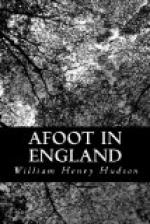gazing on such a landscape the brown, harsh, scanty
vegetation of the hilltop seemed all the more grateful.
The heath was an oasis and a refuge; I rambled about
in it until my feet and legs were wet; then I sat
down to let them dry and altogether spent several agreeable
hours at that spot, pleased at the thought that no
human fellow-creature would intrude upon me.
Feathered companions were, however, not wanting.
The crowing of cock pheasants from the thicket beside
the old road warned me that I was on preserved grounds.
Not too strictly preserved, however, for there was
my old friend the carrion-crow out foraging for his
young. He dropped down over the trees, swept
past me, and was gone. At this season, in the
early summer, he may be easily distinguished, when
flying, from his relation the rook. When on
the prowl the crow glides smoothly and rapidly through
the air, often changing his direction, now flying
close to the surface, anon mounting high, but oftenest
keeping nearly on a level with the tree tops.
His gliding and curving motions are somewhat like
those of the herring-gull, but the wings in gliding
are carried stiff and straight, the tips of the long
flight-feathers showing a slight upward curve.
But the greatest difference is in the way the head
is carried. The rook, like the heron and stork,
carries his beak pointing lance-like straight before
him. He knows his destination, and makes for
it; he follows his nose, so to speak, turning neither
to the right nor the left. The foraging crow
continually turns his head, gull-like and harrier-like,
from side to side, as if to search the ground thoroughly
or to concentrate his vision on some vaguely seen
object.
Not only the crow was there: a magpie chattered
as I came from the brake, but refused to show himself;
and a little later a jay screamed at me, as only a
jay can. There are times when I am intensely
in sympathy with the feeling expressed in this ear-splitting
sound, inarticulate but human. It is at the
same time warning and execration, the startled solitary’s
outburst of uncontrolled rage at the abhorred sight
of a fellow-being in his woodland haunt.
Small birds were numerous at that spot, as if for
them also its wildness and infertility had an attraction.
Tits, warblers, pipits, finches, all were busy ranging
from place to place, emitting their various notes
now from the tree-tops, then from near the ground;
now close at hand, then far off; each change in the
height, distance, and position of the singer giving
the sound a different character, so that the effect
produced was one of infinite variety. Only the
yellow-hammer remained constant in one spot, in one
position, and the song at each repetition was the
same. Nevertheless this bird is not so monotonous
a singer as he is reputed. A lover of open places,
of commons and waste lands, with a bush or dwarf tree
for tower to sit upon, he is yet one of the most common
species in the thickly timbered country of the Otter,
Clyst, and Sid, in which I had been rambling, hearing
him every day and all day long. Throughout that
district, where the fields are small, and the trees
big and near together, he has the cirl-bunting’s
habit of perching to sing on the tops of high hedgerow
elms and oaks.




